UH 60 Black Hawk Pilot Training: What You Need to Know
Comprehending the Function and Importance of Various UH60 Components in Aeronautics Procedures
In the detailed globe of air travel procedures, every part of a UH60 helicopter plays a vital function in ensuring risk-free and effective flights. From the blades system to the landing equipment, each component has a details function that adds to the general performance of the aircraft. Understanding the ins and outs of these parts is not only important for the upkeep personnel but also for the pilots who depend on the seamless procedure of every component for a successful goal. As we explore the relevance of the rotor system, engines, avionics, transmission system, and touchdown gear in UH60 procedures, a deeper recognition for the synergy of these aspects emerges, clarifying the intricacies that underpin the air travel market's commitment to accuracy and integrity.
Rotor System
The blades system, a crucial part in helicopter design, plays an essential function in giving lift and directional control during flight. Including the primary rotor and tail rotor, this system is in charge of creating the required wind resistant forces to keep the helicopter maneuverable and airborne. The main blades, generally situated over the helicopter, is the key resource of lift. As the rotor blades rotate, they produce a pressure difference between the leading and bottom surfaces, allowing the helicopter to get over gravity and ascend into the air.
Additionally, the major blades likewise permits the helicopter to move in various directions by turning the blades disc. By changing the angle of the rotor blades jointly, pilots can control the helicopter's forward, backwards, and sideways movements. On the other hand, the tail blades, positioned at the tail end of the helicopter, counteracts the torque generated by the primary blades's rotation, ensuring the helicopter remains balanced and can make regulated turns. Together, these rotor components form a sophisticated system that allows helicopters to execute a vast array of flight maneuvers efficiently and securely.

Engines
In aviation operations, the appropriate performance of engines is critical to enhancing the rotor system's aerodynamic capacities in helicopters. These turboshaft engines are important elements that power the major rotor transmission, tail rotor system, and other necessary helicopter systems. uh 60.
In instance of engine breakdowns or emergency situations, pilots depend on their training and the helicopter's style attributes to implement necessary treatments quickly and safely. In general, the engines in UH60 helicopters are vital elements that add considerably to the airplane's functional success and objective performance.
Avionics
Avionics innovation plays a critical function in modern air travel operations, integrating digital systems for airplane, communication, and navigation monitoring. In the UH60 helicopter, avionics incorporate a large range of systems that make certain safe and effective flight. uh 60. These systems include communication equipment, such as radios and transponders, which allow pilots to interact with air traffic control service and other aircraft. Navigating systems, like GPS and inertial navigating units, provide accurate positioning info to the staff, assisting in route preparation and making certain exact navigation during trips. In addition, avionics consist of trip management systems that help automate different jobs, such as autopilot functions and trip data recording.
Additionally, avionics play an important function in improving situational understanding for pilots, enabling them to check critical flight specifications, weather condition problems, and possible dangers in real-time. By providing crucial data and automation capabilities, avionics add considerably read more to the safety and security, efficiency, and overall efficiency of UH60 helicopters in varied air travel procedures.
Transmission System
An integral part of the UH60 helicopter's functionality and efficiency is its transmission system. The transmission system in a UH60 helicopter is in charge of moving power from the engines to the major rotor and tail blades systems. This vital part makes sure that the helicopter can navigate successfully and preserve security during flight operations.
The transmission system in the UH60 helicopter contains various parts, consisting of the major transmission, intermediate transmission, tail gearbox, and drive shafts. Each of these elements plays a critical function in ensuring that power is distributed effectively throughout the airplane.
The main gearbox is specifically vital as it moves power from the engines to the major rotor system, enabling the helicopter to take off the ground and accomplish ahead, in reverse, and lateral movement. The tail transmission, on the various other hand, transfers power to the tail blades, which helps counteract the primary blades's torque and offers directional control.
Landing Equipment


The landing gear of the UH60 helicopter offers as an essential part for making sure risk-free and stable ground operations, complementing the capability of its transmission system. Being composed of wheels, shock absorbers, check here and support structures, the landing equipment supports the helicopter's weight throughout launch, landing, and while on the ground. Routine examinations, lubrication, and replacement of worn-out parts are necessary to promote the integrity and efficiency of the touchdown gear system.
Conclusion
Finally, the different components of the UH60 helicopter play important functions in guaranteeing the smooth operation of aviation tasks. uh 60. The blades system, engines, avionics, transmission system, and touchdown equipment all interact to make certain the safety and effectiveness of the aircraft. Understanding the importance of each element is vital for pilots, designers, and maintenance team to make sure the total functionality of the UH60 helicopter during flight procedures
